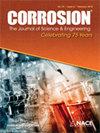利用点缺陷理论表征微结构对奥氏体不锈钢钝化稳定性的影响
IF 1.1
4区 材料科学
Q4 MATERIALS SCIENCE, MULTIDISCIPLINARY
引用次数: 0
摘要
评估了奥氏体不锈钢 UNS N31603 的微观结构对抗点蚀电位的影响,以解释碳化物等特征分布的影响。通过表面激光熔化(SLM)和在 600°C、700°C 和 800°C 下敏化处理,获得了不同的微观结构。电化学测试所用的测试溶液包括室温条件下 pH 值为 8 的缓冲盐水。无源条件的表征是通过电位动力、电位静态和莫特-肖特基技术完成的。结果表明,通过 SLM 生产的 UNS N31603 样品具有更高的被动层稳定性。与微观结构特征的相关性表明,这是因为 SLM 工艺中缺少夹杂物和碳化物。使用点缺陷模型描述被动层行为对实验结果进行的分析表明,被动层的稳定性先验地与金属阳离子和阴离子空位扩散率成反比。实验揭示了点缺陷模型与被动层特性的密切关系并解释了被动层的特性。本文章由计算机程序翻译,如有差异,请以英文原文为准。
Characterization using point defect theory of the microstructure effect on passivity stability in austenitic stainless steel
The influence of the microstructure on the resistance to pitting potential in austenitic stainless steel UNS N31603 is evaluated to explain the effect of the distribution of features such as carbides. Different microstructures were obtained by processing, via surface laser melting (SLM) and sensitized at 600°C, 700°C and 800°C. The test solution used for electrochemical testing included a buffer pH 8 brine at room conditions.
The characterization of the passive conditions is done by using potentiodynamic, potentiostatic and Mott Schottky techniques. The results show that the UNS N31603 samples produced by SLM have higher passive layer stability. The correlation with the microstructural features attribute this to a lack of inclusions and carbides characteristic of the SLM process. The analysis of the experimental results using the point defect model description of the passive layer behavior indicates that the stability of the passive layer is a priori inversely proportional to both the metal cation and anion vacancy diffusivities. Experiments reveal the close dependence and explain the properties of the passive layer with respect to a Point defect model.
求助全文
通过发布文献求助,成功后即可免费获取论文全文。
去求助
来源期刊

Corrosion
MATERIALS SCIENCE, MULTIDISCIPLINARY-METALLURGY & METALLURGICAL ENGINEERING
CiteScore
2.80
自引率
12.50%
发文量
97
审稿时长
3 months
期刊介绍:
CORROSION is the premier research journal featuring peer-reviewed technical articles from the world’s top researchers and provides a permanent record of progress in the science and technology of corrosion prevention and control. The scope of the journal includes the latest developments in areas of corrosion metallurgy, mechanisms, predictors, cracking (sulfide stress, stress corrosion, hydrogen-induced), passivation, and CO2 corrosion.
70+ years and over 7,100 peer-reviewed articles with advances in corrosion science and engineering have been published in CORROSION. The journal publishes seven article types – original articles, invited critical reviews, technical notes, corrosion communications fast-tracked for rapid publication, special research topic issues, research letters of yearly annual conference student poster sessions, and scientific investigations of field corrosion processes. CORROSION, the Journal of Science and Engineering, serves as an important communication platform for academics, researchers, technical libraries, and universities.
Articles considered for CORROSION should have significant permanent value and should accomplish at least one of the following objectives:
• Contribute awareness of corrosion phenomena,
• Advance understanding of fundamental process, and/or
• Further the knowledge of techniques and practices used to reduce corrosion.
 求助内容:
求助内容: 应助结果提醒方式:
应助结果提醒方式:


